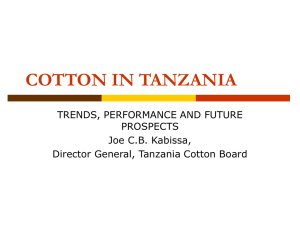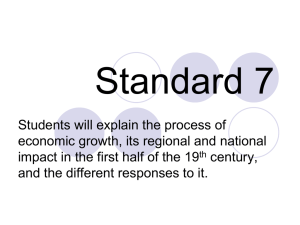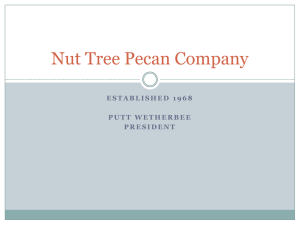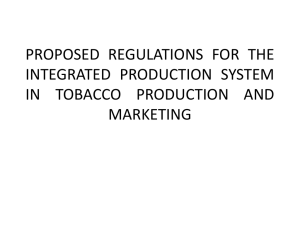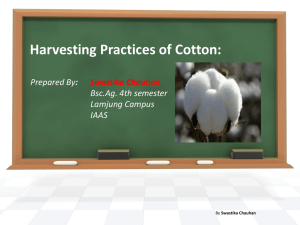How is climate data being used by the cotton industry to manage
advertisement
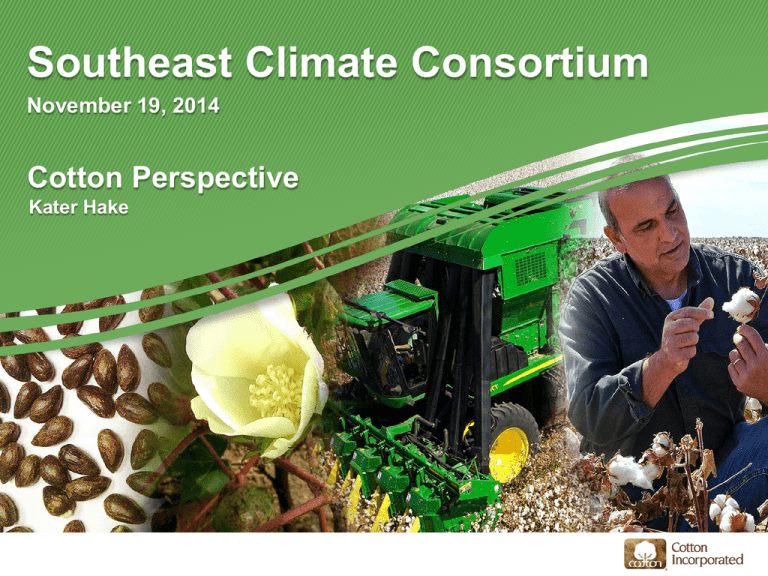
Southeast Climate Consortium November 19, 2014 Cotton Perspective Kater Hake How is climate data being used by the cotton industry to manage risks? • Context (geographic, ecological, type of system) • How is information being used to support decisions? • Who are key stakeholders and how are you interacting with them? • Who are your partners? • Lessons learned, questions you have for this audience. How is climate data being used by the cotton industry to manage risks? • Context (geographic, ecological, type of system) • How is information being used to support decisions? Farming Entire US • Who are key stakeholders and how are you interacting with them? • Who are your partners? • Lessons learned, NO questions you have for this audience. How is climate data being used by the cotton industry to manage risks? • How is information being used to support decisions in an operational context of growers, research, promotion, and policy • Who are key stakeholders and how are you interacting with them? • Who are your partners? NCC 20,000 • Lessons learned, questions you have for this cotton audience.NCC & Cotton farmers Incorporated CCI & Cotton Incorporated Grower Use of Climate Data • Pass the farm & lifestyle to their grandchildren • Long term decisions regarding: – which field to buy, sell, or rent based on anticipated productivity – investing in irrigation, terracing or land leveling – diversifying geographically or with perennial or new annual crops. (new annual crops still need long term investment in infrastructure, markets, and expertise) • Managing the farm for today Urumuqi, Xinjiang 43°N Lubbock, Texas 33°N Using Weather & Climate for Cotton Management Highly predictable temperatures allows good farmers to extract every possible heat unit out of the spring and fall by avoiding cold snaps Fortunately mid-season weather is more favorable because we can not avoid it. Variable spring temperatures dictate delayed planting to avoid stand failure, chilling injury, root injury Split fertilizer applications reduce nutrient loss from excess spring & summer rain causes nutrient loss, Install supplemental irrigation to counter hot summer days that increase water use and chance of drought Select varieties with high heat tolerance to maintain good seed set Anticipate that late summer drought will reduces yield and fiber quality Employ earlyness practices to mature the crop before a moderate chance of a freeze US growers are beginning to use climate data In Texas “La Nina” means “Less Agua” Policy Uses of Climate Data • Current “Farm Bill” focused on crop insurance • NRCS-EQIP soil & water conservation funding • Research Priorities communicated by NCC and Cotton Incorporated Research policy just barely uses climate data “Resilience. The cotton plant has the natural advantage over other crops in its inherent tolerance to drought and stress. Conservation tillage has boosted this further with enhanced rainwater capture and soil moisture storage. Advancing cotton’s tolerance even further brings substantial benefits to society by expanding agriculture’s resilience where limited water and infertile soils previously limited economic growth. Food, feed, and cash can be produced where no other crop can grow. Expansion of cotton’s drought and stress tolerance requires innovative approaches to breeding and field management. Cutting edge sciences such as: soil microbiological health, genotyping, molecular marker development, High Through Put field phenotyping, wild germplasm introgression, and seedling establishment innovations will be helpful in this effort.” Jointly presented to the USDA-ARS Administrator by NCC and Cotton Incorporated on 4-15-2014 Agricultural research is strongly influenced by climate data • Cotton Incorporated (also other commodities) that invest in research within the public sector look for ROI in 5 to 25 years, even longer with scientist training and foundational research • NAM • HTP phenotyping • Exotic germplasm check • Drought tolerance varieties • Water management • Soil health BarbRen Water Management Maximize Rainfall Capture & Runoff Supplemental Irrigation Soil and Root Health Breed Stress Tolerant Cottons Promotion subtlety uses climate data How is climate data being used by the cotton industry to manage risks? • Context (geographic, ecological, type of system) • How is information being used to support decisions? • Who are key stakeholders and partners, and how are you interacting with them? • Who are your partners? • Lessons learned, questions you have for this audience. • MY BOSS is ~500 grower leadership growers (our Board of Directors is composed of 150 and NCC Board is 50 grower leaders) • OUR COOPERATORS include 295 research labs in 55 University and USDA-ARS institutions who we fund • WE COLLABORATE closely with research counterparts of corn, soy, wheat and sorghum • NCC tries to influence policy at all levels How is climate data being used by the cotton industry to manage risks? • Context (geographic, ecological, type of system) • How is information being used to support decisions? • Who are key stakeholders and how are you interacting with them? • Who are your partners? • Lessons learned, questions you have for this audience. Lessons Learned & Questions/Requests 1. Cultivate capacity with grower leadership. One well respected grower with clear arguments is hugely influential Lessons Learned & Questions/Requests 1. Cultivate capacity with grower leadership. One well respected grower with clear arguments is hugely influential • Help build resilience. Skeptics & believers benefit! • Help agriculture do a better job of integrating weather and climate into decision making • Collaborate with industry on www.agroclimate.org • Give us a robust 30 day forecast for rain and temp • Help agriculture insure against extreme events Thank You







